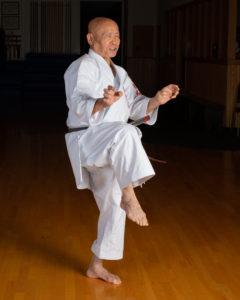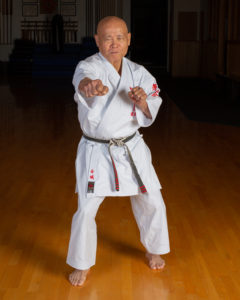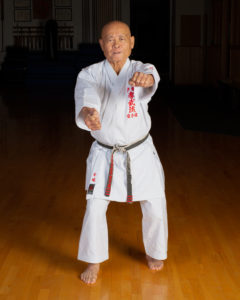Taisabaki Waza
The taisabaki waza are designed to teach effective body movement. Like shokyū, the taisabaki waza should be first practiced in a simplified way to internalize accurate body movement. Because taisabaki waza drills alternate left and right sides, the student is also developing the skillful use of both sides of the body.
At first taisabaki waza may seem like a thing apart from the kata. However, you will find the taisabaki wazi in advanced kata and in kata bunkai. Kyū level Kōburyū students should practice taisabaki wazi bunkai until the movements become natural.the taisabaki waza include not only basic movements but also combinations from more advanced kata. While first practiced at shokyū level, the taisabaki waza are later practiced in a chūkyū and even jōkyū fashion, using the legs for power, grabbing for control, simultaneous block and attack and other skills necessary to move from beginner performance of a kata to true understanding of a mock battle. You cannot go on to more advanced techniques until the tai sabaki waza are mastered.
Taisabaki Waza Bunkai
Through taisabaki waza drills the student learns to control his or her own body movements. Through taisabaki waza bunkai the student learns how to take control of the opponent’s body, moving it or manipulating as necessary. This is especially important to joint locks and throwing techniques. More than just timing and distance, taisabaki waza bunkai offers the opportunity to practice the turning and evasion techniques of tenshin, grabbing for control, the strong stepping of fumikomi as well as correct use of the hips and pelvis, feet and legs, arms and hands.
Avoid non-essential movement. Each technique must be made decisively, with strength, speed, and proper positioning. It must also be small and controlled for efficiency, avoiding wasted motion which can lead to weakness in the defense. The taisabaki waza are designed to be executed from a stable stance. During bunkai, obtaining a stable stance can be more difficult, since you have the attacker’s energy, strength and weight to deal with.
Even beginners can work with a partner to learn the most basic version of each taisabaki waza bunkai. Since the taisabaki waza are not presented in order from easy to more difficult, the sensei should decide which taisabaki waza bunkai the student is ready for.
The Taisabaki Waza in Detail
Correct posture, foot placement, hip alignment and balance must be maintained. Execute each taisabaki waza with the appropriate weight distribution. Depending on the taisabaki waza , this can mean raising or lowering the body, shifting forward or back, pivoting on the balls of the feet, moving one’s weight onto one or both feet, or a combination of the above.
Not Just Warmups
The following set of taisabaki waza are often practiced as warm-ups, but they are more than that.
1. Jōdan □ Chūdan □ Gedan No Tsuki (Jō Chū Ge No Tsuki)
| jōdan | 上段 | jō | upper |
| chūdan | 中段 | chū | middle |
| gedan | 下段 | ge | lower |
| dan | 段 | level | |
| tsuki | 突き | punch |
上 中 下 の 突き
2. Gedan □ Chūdan □ Jōdan □ Sokutō Geri (Ge Chū Jō Sokutō Geri)
| gedan | 下段 | ge | lower |
| chūdan | 中段 | chū | middle |
| jōdan | 上段 | jō | upper |
| dan | 段 | level | |
| sokutō | 足刀 | knife edge of foot | |
| geri | 蹴り | kick |
下 中 上 足刀 蹴り
3. Tateken Chūdan □ Shō Jōdan □ Hiji Uchi (Tateken Shōte Yoko Hiji)
| tateken | 縦拳 | vertical fist |
| chūdan | 中段 | middle level |
| shō shōte | 掌 掌手 | palm of the hand |
| jōdan | 上段 | upper level |
| yoko | 横 | side to side |
| hiji | 肘 | elbow |
| uchi | 打ち | strike |
縦拳 掌手 横肘
4. Kakato Geri
| kakato | 踵 | heel |
| geri | 蹴り | kick |
5. Ryōte Uraken Uchi
| ryōte | 両手 | both hands |
| uraken | 裏拳 | back of fist |
| uchi | 打ち | strike |
For the Young and Young at Heart
The following two taisabaki waza are great strength training for the legs, but without much practical application,
6. Kaiten Mawashi Geri
| kaiten | 回転 | around |
| mawashi | まわし 回し | turn or rotate |
| geri | 蹴り | kick |
7. Mawashi Tobi Geri
| mawashi | まわし 回し | turn or rotate |
| tobi | とび 跳び | jump |
| geri | 蹴り | kick |
The Core Taisabaki Waza
| yakusoku | 約束 | pre-arranged |
| kumite | 組み手 | fighting |
| bunkai | 分解 | analysis |
| ōyō | 応用 | practical application |
As dan level promotion candidates, advanced students are asked to develop their own ideas for practical applications of the taisabaki wazi or to combine taisabaki waza and kata movements into a practical defense. These practical applications are called ōyō. The ōyō must be practical and the presentation should approach the look of a real fight and not go on and on like a sparring match. Remember, the goal of karate is to stop the fight. Sōke Kaichō Kinjō hopes to see the movements of tai sabaki waza effectively employed in bunkai and ōyō when he returns for future visits.
By comparison, Uechi Ryū shodan candidates also demonstrate mock fights with prearranged attack and defense called yakusoku kumite, “promise fighting.” Like Kōburyū, the goal is to make the fight as realistic as possible, but still remain safe. Unfortunately, the Uechi Ryū yakusoku kumite are pre-defined and offer no room for creativity.
1. Jōdan Tsuki Uke
| jōdan | 上段 | upper |
| tsuki uke | 突き受け | punch block |
2. Jōdan Tsuki Uke □ Gyaku-te Seiken Zuki
| jōdan | 上段 | upper |
| tsuki uke | 突き受け | punch block |
| gyaku | 逆 | opposite |
| seiken | 正拳 | regular fist |
| zuki | 突き | punch |
3. Ryōte Tsuki Uke
| ryōte | 両手 | both hands |
| tsuki uke | 突き受け | punch block |
4. Kōsa Uke □ Shō Oshikomi
| kōsa uke | 交刃受け | cross block |
| shō | 掌 | palm of the hand |
| oshikomu | おし 込み 押し込み | push into |
5. Kōsa Uke □ Zensoku Geri
| kōsa uke | 交刃受け | cross block |
| zensoku | 前足 | front foot/leg |
| geri | 蹴り | kick |
6. Kōsa Uke Dōji Geri
| kōsa uke | 交刃受け | cross block |
| dōji | 同時 | simultaneous |
| geri | 蹴り | kick |
7. Gedan Tsuki Uke □ Ryōte Mawashi Ashi Barai
| gedan | 下段 | lower level |
| tsuki uke | 突き受け | punch block |
| ryōte | 両手 | both hands |
| mawashi | まわし 回し | turn or rotate |
| ashi | 足 | foot/leg |
| barai | 払い | sweep away |
8. Gedan Tsuki Uke □ Sukui Age □ Zensoku Geri
Sokutō
| gedan | 下段 | lower level |
| tsuki uke | 突き受け | punch block |
| sukui age | すくい あげ | scoop up |
| zensoku sokutō | 前足 足刀 | front foot/leg knife edge of foot |
| geri | 蹴り | kick |
9. Gedan Tsuki Uke □ Sono Te De Jōdan Age Uke□ Gyaku-te Chūdan Zuki
| gedan | 下段 | lower level |
| tsuki uke | 突き受け | punch block |
| sono te de | その手で | with that hand |
| jōdan | 上段 | upper level |
| age uke | あげ受け | rising block |
| gyaku te | 逆手 | opposite hand |
| chūdan | 中段 | middle level |
| zuki | 突き | punch |
10. Kōsa Uke Kara □ Ryōte Shō Oshidashi
| kōsa uke | 交刃受け | cross block |
| kara | から | from |
| ryōte | 両手 | both hands |
| shō | 掌 | palm of the hand |
| oshidashi | 押し出し | push out |
11. Kōsa Uke □ Ryōte Shutō Kubi Uchi
| kōsa uke | 交刃受け | cross block |
| ryōte | 両手 | both hands |
| shutō | 手刀 | sword hand |
| kubi | 首 | neck |
| uchi | 打ち | strike |
12. Kōsa Uke □ Shutō Suihei Uchi
| kōsa uke | 交刃受け | cross block |
| shutō | 手刀 | sword hand |
| suihei | 水平 | horizontal |
| uchi | 打ち | strike |
13. Kōsa Uke □ Shutō Ōfuku Uchikomi
| kōsa uke | 交刃受け | cross block |
| shutō | 手刀 | sword hand |
| ōfuku | 往復 | round trip |
| uchikomi | 打ち込み | push into |
14. Kōsa Uke Dōji Shō Ganmen Uchi □ Gyaku-te Chūdan Zuki
| kōsa uke | 交刃受け | cross block |
| dōji | 同時 | simultaneous |
| shō | 掌 | palm of the hand |
| ganmen | 顔面 | face |
| uchi | 打ち | strike |
| gyaku te | 逆手 | opposite hand |
| chūdan | 中段 | middle level |
| zuki | 突き | punch |
15. Kōsa Uke □ Gedan Shō De Kime □ Sono Te De Ganmen Uraken Uchi
| kōsa uke | 交刃受け | cross block |
| gedan | 下段 | lower level |
| shō de | 掌で | with the palm of the hand |
| kime | 決め | deliver |
| sono te de | めその手で | with that [same] hand |
| ganmen | 顔面 | face |
| uraken uchi | 裏拳打ち | strike with back of the fist |
The word kime, meaning “to deliver,” is used when a strike is not strictly a thrust or hit.
16. Kōsa Uke □ Shutō Suihei Uchi □ Zensoku Kakato Geri
| kōsa uke | 交刃受け | cross block |
| shutō | 手刀 | sword hand |
| suihei | 水平 | horizontal |
| uchi | 打ち | strike |
| zensoku | 前足 | front foot/leg |
| geri | 蹴り | kick |
17. Kōsa Uke □ Shutō Suihei Uchi □ Kōsoku Kakato Geri
| kōsa uke | 交刃受け | cross block |
| shutō | 手刀 | sword hand |
| suihei | 水平 | horizontal |
| uchi | 打ち | strike |
| kōsoku | 後足 | back foot/leg |
| geri | 蹴り | kick |
18. Zensoku Kakato Geri Dōji Ni Uraken To Seiken Zuki
| zensoku | 前足 | front foot/leg |
| kakato | 踵 | heel |
| geri | 蹴り | kick |
| dōji ni | 同時 に | simultaneously |
| uraken | 裏拳 | back fist |
| to | と | and |
| seiken | 正拳 | regular fist |
| zuki | 突き | punch |
19. Kōsa Uke □ Hiza Geri
| kōsa uke | 交刃受け | cross block |
| hiza | 膝 | knee |
| geri | 蹴り | kick |
20. Kōsa Uke □ Yoko Hiji Uchi
| kōsa uke | 交刃受け | cross block |
| yoko | 横 | side to side |
| hiji | 肘 | elbow |
| uchi | 打ち | strike |
21. Kōsa Uke □ Tate Hiji Uchi
| kōsa uke | 交刃受け | cross block |
| tate | 縦 | vertical |
| hiji | 肘 | elbow |
| uchi | 打ち | strike |
22. Kōsa Uke □ Furi Hiji Uchi
| kōsa uke | 交刃受け | cross block |
| furi | 振り | swinging |
| hiji | 肘 | elbow |
| uchi | 打ち | strike |
23. Kōsa Uke □ Shūkoken Uchi Dōji Ni Shō Oshikomi
| kōsa uke | 交刃受け | cross block |
| shūko | 手甲 | back of the hand/wrist |
| ken | 拳 | fist |
| uchi | 打ち | strike |
| dōji ni | 同時に | simultaneously |
| shō | 掌 | palm of the hand |
| oshikomi | 掌押し込み | push into |
24. Ryōte Hiki Uke □ Kōsoku Chūdan Geri
| ryōte | 両手 | both hands |
| hiki | 引き | pull |
| uke | 受け | block |
| kōsoku | 後足 | back foot/leg |
| chūdan | 中段 | middle level |
| geri | 蹴り | kick |
Why Learn the Names in Japanese?
The Japanese names for the taisabaki waza are not really names. They are descriptions of the moves. As such, the wording sometimes changes. We could give the descriptions wholly in English, but giving the names in English would take more words to be perfectly clear. Most of the taisabaki waza terms are used over and over again in many contexts, and can be remembered almost without effort. Besides, knowing the Japanese terms makes it easier for us to understand Sōke Kaichō Kinjō.
An Aid to Memorizing
Unless you expect to be asked to lead taisabaki waza you can relax and concentrate on the training. For those who do lead, memorizing the order can be challenging. The core taisabaki waza can be roughly divided into groups as an aid to memory. I offer my names, but call the groups what you like. Good luck.
| 1-3 | Upper |
| 4-6 | Middle |
| 7-9 | Lower |
| 10-12 | Easy ones |
| 13-15 | Combinations |
| 16-17 | Back to suihei |
| 18-19 | Odd ones |
| 20-22 | Elbow strikes |
| 23 – 24 | Last two |



